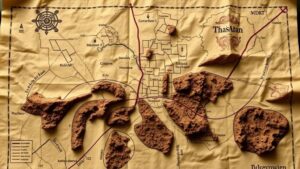How to Detect Coins and Relics Hidden Among Iron Debris
How to Detect Coins and Relics Hidden Among Iron Debris
The art of metal detecting has captured the imagination of hobbyists, historians, and archaeologists alike. Among the challenges faced by metal detectorists is locating coins and relics amidst iron debris. This article explores effective strategies and methodologies for detecting valuable items in such challenging environments, taking into account the various technologies and techniques available today.
Understanding the Challenges of Iron Debris
Iron debris often poses a significant challenge for those seeking to uncover hidden treasures. presence of iron can generate interference, leading to false signals or masking the signals from more valuable artifacts. This phenomenon, known as masking, can prevent hobbyists from successfully identifying target items. So, understanding how to navigate these challenges is essential.
Types of Metal Detectors
Choosing the appropriate metal detector can greatly enhance your chances of success when searching among iron debris. e are two primary types of detectors that are particularly effective in these environments:
- Pulse Induction (PI) Detectors: These detectors send powerful bursts of energy into the ground and are capable of detecting deeply buried objects. They excel in high-iron environments, though the drawback is that they may struggle to discriminate between metals.
- Multi-Frequency Detectors: These have the ability to detect multiple frequencies simultaneously, significantly improving the ability to differentiate between target metals, including coins and other relics.
For example, the Minelab CTX 3030 is a multi-frequency detector that performs exceptionally well in iron-heavy conditions, allowing users to locate desirable items while filtering out the signals from unwanted iron debris.
Techniques for Effective Searching
Employing the right techniques during metal detection can enhance the efficiency and effectiveness of your search. Consider the following methods:
- Ground Balancing: Proper ground balancing ensures that the detector is tuned to the mineralization of the soil, minimizing the response to iron. This is a crucial step in ensuring accurate readings.
- Adjusting Sensitivity: Reducing sensitivity can help filter out high-frequency signals from iron debris. Start at higher sensitivity levels and gradually decrease it until you find a balance that works for your environment.
- Search Patterns: Use a systematic search pattern, such as a grid or overlapping sweeps, to ensure comprehensive coverage of the search area. This methodology can prevent you from missing valuable items hidden amongst debris.
Observation and Interpretation of Signals
Learning to interpret the signals emitted by your detector is critical to distinguishing between valuable finds and iron debris. Most modern metal detectors offer a visual display that gives a target ID or tone variation:
- Tone Variation: Many detectors produce different tones for various types of metals. A higher-pitched tone often indicates non-ferrous targets like coins, while low-pitched tones are typical of iron.
- Target ID Numbers: Understanding target ID numbers can help in making informed decisions about whether to dig. For example, most modern detectors assign ID numbers ranging from 0 (iron) to 99 (highly conductive metals), with coins typically falling between 30 and 90.
Case Study: The Discovery of a Lost Trove in an Old Battle Site
A notable case exemplifying these techniques involved a group of enthusiasts searching a well-known Civil War battlefield littered with iron artillery debris. Using Minelabs CTX 3030 detectors, the team employed ground balancing and adjusted their sensitivities. They adopted a grid search pattern and meticulously adjusted their detection settings to filter out signals from iron. After a few days of searching, they unearthed a trove of civil war-era coins and buttons, highlighting the effectiveness of proper techniques and tools.
Real-World Applications of Technology
Recent advancements in technology have significantly streamlined the process of detecting coins and relics hidden in iron debris:
- Smartphone Apps: Applications linked to metal detectors can help track search history and overlay detected signals on digital maps, enhancing the research capabilities of hobbyists.
- 3D Imaging Technology: Some modern detectors use 3D imaging to visualize the depth and size of potential targets, providing crucial information before excavation.
Conclusion
Detecting coins and relics hidden among iron debris remains a complex yet rewarding pursuit. combination of selecting the right detector, employing effective techniques, and mastering the interpretation of signals significantly improves the chances of success. Armed with these insights and advancements in technology, metal detectorists can delve into the rich world of hidden treasures with greater confidence.
Actionable Takeaways
- Invest in a quality multi-frequency or pulse induction detector suited for iron-heavy environments.
- Master ground balancing and adjust your detector settings before each hunt.
- Employ systematic search patterns and practice interpreting tones and target ID numbers.
- Stay updated on advancements in technology that can aid in metal detecting.
By applying these strategies and leveraging modern technology, you will enhance your metal detecting experiences and increase your chances of uncovering valuable finds amid iron debris.


